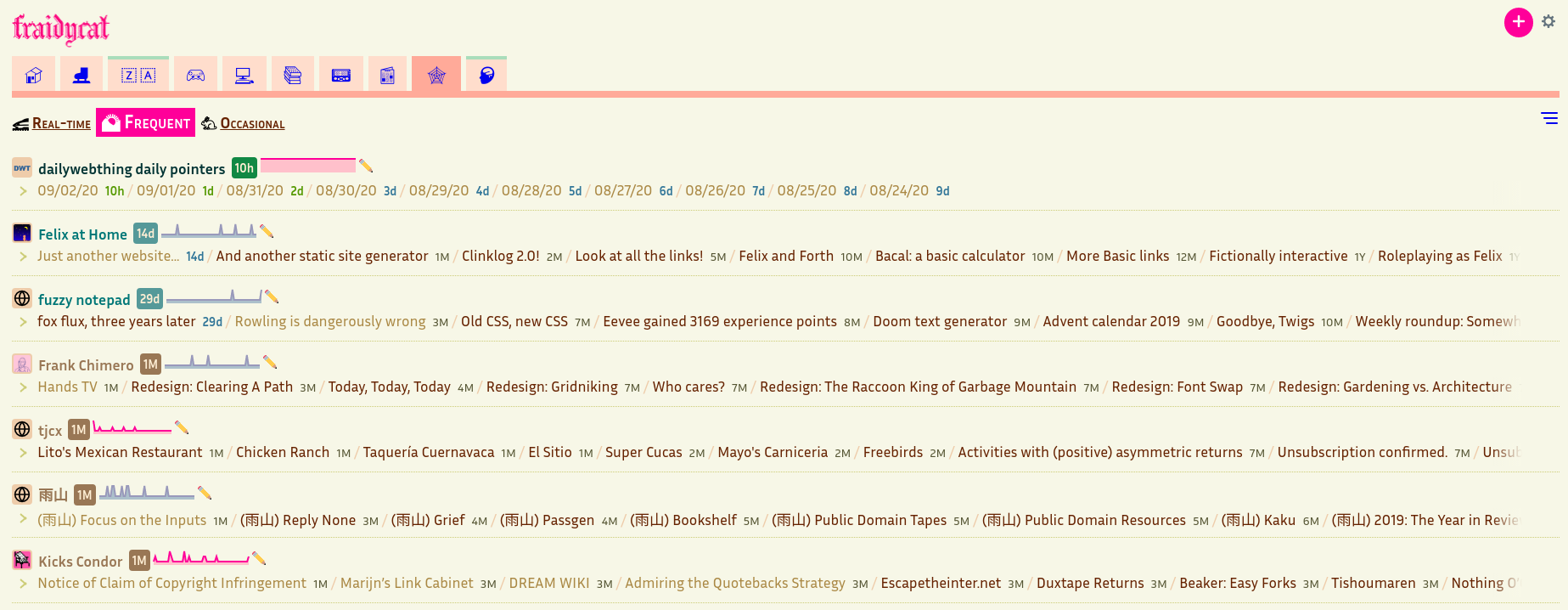Long-time readers will know that I’m a big fan of RSS feeds. An RSS reader has been essential to my web experience since I first came online, and I’ve doggedly stuck to using them even as the web has centralised onto a few platforms and much digital ink spilt about the “death of RSS”. Luckily, I’m not the only one who prefers this old-school, human-curated approach to the web over today’s platforms and their algorithms.
Fraidycat is a browser extension for following people on the web, created by someone named Kicks Condor, whose main internet presence as of this writing appears to an elaborate act of performance art. Previously it was a blog, and maybe it will be one again, who can say?
Like a latter day _why, Kicks combines clever programming with a colourful and quirky aesthetic to create software that is both useful and a little odd, hence the name and colourscheme.

Fraidycat with some of my subscriptions
Fraidycat differs from traditional RSS readers (ala the late Google Reader) in two key ways:
1. It’s not just an RSS reader. In addition to RSS (and Atom, and JSON) feeds, you can use Fraidycat to follow Twitter and Instagram accounts, Youtube channels, TiddlyWikis, indieweb h-feeds and a whole bunch more. The explicit goal of the project is provide a universal interface for following people regardless of the platforms they use.
Although I don’t share the author’s complete aversion to using social media sites, I find Fraidycat very useful for following a few high signal-to-noise accounts on various platforms, so I can make sure I see everything they post.
2. It doesn’t look like an email client. Most feed readers carefully track and even save each post from each of your subscriptions. Posts are marked as read or unread, and, where possible, the full body text of each post is embedded in the reader’s interface. Fraidycat doesn’t even try to do either of these things. No distinction is made between read and unread items (beyond your browser’s visited/unvisited link colouration), and no tally is kept. No interface exists for reading post content. Every site/account you subscribe to is shown with links to its ten most recent posts. Clicking a link takes you to the post in question, and if you want to see the eleventh most recent post, well, you can go to the site itself.
These feature omissions are my favourite things about Fraidycat. I follow a lot of different sites for a lot of different reasons. With some, I want to read every post. With others, I just want to see the latest headlines and dip in when one catches my eye. Every RSS reader I’ve used in the past has irritated me by running up unread counts for the latter category.
As I mentioned in my post about browser reader modes, I usually prefer to read articles on their original websites – partly so that they don’t all blend together like Medium sludge, and partly because syndicated content has an uncomfortably high probability of losing formatting and even chunks of text. So Fraidycat’s philosophy of linking rather than rendering is ideal for my usecase. The world could probably do with more developers who intentionally leave out features.
Fraidycat allows you to categorise your subscriptions on two levels: category and importance. Categories are up to you to define, and are shown as tabs at the top of the page. One subscription can appear in multiple categories. Kicks’s preferred aesthetic is to use emojis as category names, but you can use words too.
Importance is unique to Fraidycat, and provides a way for you to prioritise content and shape your reading habits. Each subscription can appear in one of the below importances:

This allows you to determine how often you’ll want to check in on a given site/account/person, which is likely to be a function of how frequently they post, the lengths of their posts, and how interested you are in their content. A favourite Twitter account, for example, may be placed in Real-time, while a rarely updated blog, or one you seldom have time to read, may be placed in Sometimes, to be glanced at when you’re not doing anything else.
I wasn’t completely sold on this feature when I first started using Fraidycat, as I’d often forget to check the last two tabs, but that’s basically the point of having them – not everything needs to be checked for updates all the time. In any case, you can just put everything in Real-time or Frequent and never bother with time sensitivity if it doesn’t work for you.
Before switching to Fraidycat about a year ago, I used web-based RSS readers like Feedly and Inoreader. My main concern with switching was that my subscriptions would be tied to my main PC. Fortunately, the extension integrates with browser sync, so subscriptions will be synced between devices. This functionality didn’t exist the last time I tried using a browser extension feed reader, and its absence would have been a dealbreaker (and also a heartbreaker).
There’s currently no way to get Fraidycat on a smartphone, but I don’t need it there. Even the feeds I follow in real-time aren’t quite important enough that I need to check them when I’m not in front of a computer. Which, I think, is very much in keeping with the application’s philosophy. Fraidycat produces no notifications, applies no machine learning to your subscriptions to recommend content you might like, and doesn’t gamify your actions or track you. You choose who to follow and how to follow, and the app does nothing outside of that. Fraidycat is the best RSS reader I’ve ever used because of what it leaves out.
 David Yates.
David Yates.
 Fraidycat said on
6 September 2020:
Fraidycat said on
6 September 2020: